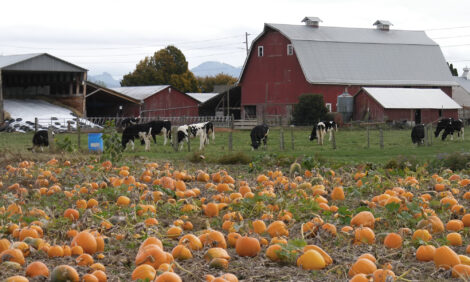



UI extension specialists help dairy producers meet dairy net zero initiative
Producers skeptical that the net-zero goal is realistic, researchers sayUniversity of Idaho agricultural economists have been conducting research and outreach to help dairy producers meet an ambitious industry-wide goal of becoming carbon neutral by 2050, according to a news release issued by the university.
The Innovation Center for US Dairy launched the US Dairy Net Zero Initiative (NZI) in 2021, seeking to attain net-zero dairy greenhouse gas emissions within the next three decades.
Xiaoli Etienne, Idaho Wheat Commission Bill Flory endowed chair in risk management; Hernan Tejeda, an agricultural economist; and Andres Trujillo-Barrera, director of the Agricultural Commodity Risk Management Program; met in March 2023 to discuss NZI in depth with a focus group comprising a representative sample of Idaho dairies.
The Idaho Dairymen’s Association coordinated, moderated and hosted the focus group, assembled to help the researchers explore producers’ perceptions about NZI and identify the current adoption status of carbon-reduction projects, potential barriers to implementing them, opportunities for broader adoption and future research topics to help producers make the transition.
“This work is important for dairy producers because it tells us the real-world challenges and opportunities they face in striving for net-zero emissions,” Etienne said. “By exploring the perspectives of Idaho dairy producers, we can identify what’s holding them back and what can help them move forward. This can guide policies and support systems that make it easier for producers to adopt sustainable practices.”
Based on discussions with the focus group, the three economists submitted a paper, “Net Zero by 2050: US Dairy’s Climate Pledge and Lessons from Idaho,” for future publication in a scientific journal. Furthermore, Tyler Hand, who recently graduated from U of I with a master’s degree in applied economics, based a master’s thesis on the focus group’s feedback.
The researchers found that producers remain skeptical that the net-zero goal is realistic. Many worry about the long-term financial viability of emission reduction projects. Producers also expressed concerns that requiring a blanket reduction in emissions could penalize early adopters of sustainable production practices.
The paper the economists recently submitted for publication outlines several options and incentives for dairy producers to reduce emissions: building anaerobic digestors, the sale of carbon credits earned through their reductions, supporting efforts to reduce emissions within their own supply chain, producing more feed on farm to reduce transportation, raising feed without tillage, using cover crops to fix nitrogen and improving manure management to curb methane emissions.
The researchers also anticipate conducting a large, multi-year research project evaluating producer perceptions, carbon marketing opportunities and risks along the dairy supply chain.
To educate dairy producers about their options for reducing emissions, Tejeda collaborated with Washington State University colleagues and experts from throughout the country on hosting workshops. Titled “Opportunities and Risks of Carbon Markets for Dairies,” workshops were hosted March 27 in Boise and March 28 in Burley and drew about 40 dairy producers and stakeholders combined.
They also posted a series of podcasts, titled “Carbon and Cow$.” The overall project was supported with a $50,000 grant from Western Extension Risk Management Education.
“Dairy producers will have to lower their emissions, but at the same time they can benefit by doing so,” Tejeda said.
The workshops covered the risks and economics of dairies building anaerobic digesters, either to produce renewable natural gas from dairy emissions or to burn dairy emissions to generate renewable electricity, as well as opportunities to benefit from other production practices that lower their emissions. Dairies that create renewable gas or power with digestors are eligible to currently sell credits to markets in Washington, Oregon and California, where mandatory programs are already in place to curb emissions. Dairies can also benefit financially by selling the gas and power they produce in their respective markets.
Producers of renewable natural gas are eligible for federal credits quantified via renewable identification number (RINs), which is currently trading at about $3 per gallon. The Environmental Protection Agency is still working to roll out a federal credit program for renewable electricity production (eRIN).
The average Idaho dairy has a herd of about 1,700 cows, and operators would need more than double that number of cows to make a natural gas digester profitable under current economic conditions. Digesters for power production should become more viable once an eRIN incentive is established.
Building a digestor is a monumental project involving significant risk. It can take upwards of 15 years to recoup an investment in digestor equipment. Some large dairies have entered into contracts with energy companies that cover the equipment, installation and operation costs in exchange for a share of the revenue. Tejeda advises dairymen to hire legal experts to carefully evaluate such contracts.
During slumping dairy markets, dairy profits may be insufficient to cover potential biogas losses. Prices for electricity and biogas are not static, nor are incentives paid for renewable energy. For example, carbon credits paid by California dropped from about $200 per metric ton of reduced emissions in 2020 to about $68 as of early this year based on increasing number of players entering the market. Voluntary carbon markets are still being developed, and producers face the risk of dealing with people in this matter that they don’t know well. Additional hurdles include variation in yield of biogas and power, capacity constraints and maintenance and management costs.
“There’s still 25 years for this Net Zero Initiative, so nobody needs to jump the gun in the next six months to a year,” Tejeda said. “They just need to educate themselves well of all that is involved.”



